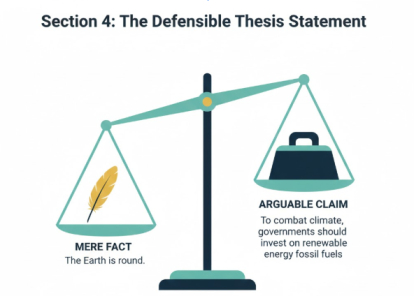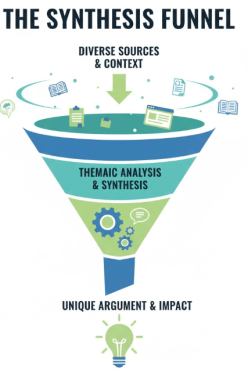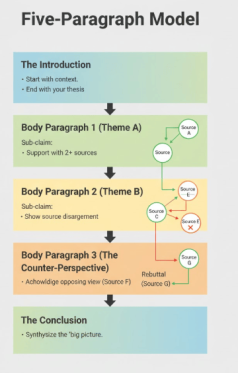Table of Contents
Writing a synthesis essay is like being the host of a dinner party where all your sources are the guests. Your job is not to let each guest give a long, isolated speech. Instead, you want to get them talking to each other to help you prove a central point. Whether you are prepping for the AP Lang exam or a college research paper, this guide will show you how to master the art of combining ideas.
A synthesis essay is a type of writing that gathers information from different sources to form a new, original argument. Unlike a typical research paper that might just report facts, a synthesis paper requires you to interpret data and show relationships between viewpoints. You are creating a “conversation” between authors to support your own unique perspective. To grab your reader’s attention right from the start, you can explore various essay hook examples that work well for academic arguments.

The biggest mistake students make is simply summarizing each source one by one. In summary, the source’s voice is the most important. In a synthesis, your voice is the leader. You should group sources by theme rather than by author. If you find yourself struggling to organize these complex ideas, an academic writing service can provide professional examples of how to blend multiple perspectives into one cohesive draft.
| Feature | Summary | Synthesis |
|---|---|---|
| Goal | To restate the main ideas of one source. | To combine multiple sources into a new idea. |
| Organization | Follows the original text’s sequence. | Organized by your own thematic claims. |
| Focus | What the author said. | How various authors’ ideas relate to each other. |
Before you type a single word, you must analyze your sources. If you are provided with six sources, you don’t necessarily need to use all of them, but you must understand how they interact. Are Source A and Source C agreeing on the economic impact but disagreeing on the social cost?

Pro Tip: Use a Synthesis Matrix.
| Themes (Rows) | Source A | Source B | Source C |
|---|---|---|---|
| Theme 1: Scalability | Mentions infrastructure limits. | Focuses on cost-efficiency. | Highlights user growth spikes. |
| Theme 2: Security | Discusses encryption types. | Not mentioned. | Focuses on social engineering. |
| Theme 3: User Experience | Emphasizes UI simplicity. | Emphasizes UI simplicity. | Argues for feature richness. |
This is a grid where the rows are the “themes” you’ve identified and the columns are the “sources.” This visualizes exactly where the “conversation” is happening.
By filling out this matrix, you ensure that every paragraph you write will contain multiple sources, which is the hallmark of high-level synthesis.
Every great synthesis essay needs a strong backbone. A defensible thesis is a claim that others might disagree with and that requires evidence to prove. It shouldn’t just state a fact; it should take a clear stand on the issue. Learning how to write a thesis statement that is both specific and argumentative is the first step toward a high-scoring paper.

Pro Tip : To test whether your thesis is defensible, ask:
A good thesis acts like a magnet—it attracts relevant ideas, evidence, and interpretations, ensuring every paragraph contributes directly to your central claim.
A strong paper starts with a powerful claim. Let our scholars help you draft a high-scoring, defensible thesis that sets you up for success.

A standard synthesis paper usually follows a five-paragraph format, but the way you organize the “inside” is what matters. You must ensure that every paragraph links back to your main argument. Before you begin drafting, it is highly helpful to learn how to write an outline so you can map out where each piece of evidence fits best.
In a synthesis essay, the Five-Paragraph Model isn’t just a container for facts; it is a structured “conversation” designed to prove your thesis. Instead of dedicating one paragraph to each source, you dedicate each paragraph to a theme where multiple sources interact.

The Anatomy of the Five-Paragraph Model
1. The Introduction (The Invitation)
2. Body Paragraph 1: The First Theme (Agreement)
3. Body Paragraph 2: The Second Theme (Nuance/Disagreement)
4. Body Paragraph 3: The Counter-Perspective (The Reality Check)
5. The Conclusion (The Final Word)
Pro Tip:
When outlining, visualize your essay as a pyramid rather than a list. Your introduction is the wide base that introduces the conversation; the body narrows toward key themes; and your conclusion brings all the threads together at the apex.
This pyramid model helps prevent repetition and ensures logical progression. Each body paragraph should feel like a step upward in sophistication and complexity—not just another block of evidence.
A perfect synthesis paragraph should never rely on just one source. Instead, try to “sandwich” your evidence. Start with your own claim, bring in Source A to support it, then bring in Source B to add more detail or offer a different angle. Because you are constantly moving between different authors’ ideas, using a plagiarism checker is a smart way to ensure you have properly cited every borrowed thought.
“The primary concern regarding the rise of urban ‘micro-apartments’ is the potential impact on mental health. While Source A argues that the efficiency of small spaces reduces the stress of high rent, Source D complicates this by citing a study where residents in units under 400 square feet reported higher levels of claustrophobia and social isolation. Therefore, the financial savings mentioned in Source A do not fully compensate for the psychological costs highlighted in Source D.”
Pro Tip: Use “Synthesis Connectors.” Words like similarly, conversely, building on this, a stark contrast is seen in, and echoing this sentiment are the glue that holds your essay together.
The conclusion is your last chance to impress the reader. Do not just repeat what you already said in the introduction. Instead, synthesize your final thoughts by showing how all the evidence points toward a broader truth or a future solution. If you need more specific tips on how to wrap up your thoughts without sounding repetitive, check out this guide on how to write a conclusion for an essay for extra inspiration.
For students specifically targeting the AP English Language and Composition exam, the “Sophistication Point” is the most difficult to earn. It isn’t just about big words; it’s about the complexity of your thought.
Sometimes, even after you have gathered all your research, your paper might still feel a bit thin. Instead of adding “fluff” or repetitive sentences, you should focus on deepening your analysis of how the sources interact with one another. There are several professional strategies on how to make an essay longer that involve expanding your “commentary”—the specific sentences where you explain the real-world significance of your evidence.
If you find yourself running out of time or struggling to connect your ideas, professional help can make a huge difference. An essay editing service can help you polish your transitions and ensure your line of reasoning is crystal clear to the reader. This ensures that your voice remains the dominant force throughout the discussion.
Finally, for those working on technical, nursing, or scientific papers, the final bibliography is just as important as the argument itself. Utilizing dedicated tools for apa referencing can ensure that your complex source list is formatted without any errors, protecting your academic integrity and saving you hours of manual work.
For most college assignments and the AP Lang exam, you should aim for at least three to four sources. Using too few prevents you from showing a true “conversation” of ideas, while using too many can make it difficult to maintain your own voice.
Yes! In fact, it is often better to use a single, strong source in different sections to show how it relates to various themes. This demonstrates that you have a deep understanding of the source material.
Commentary consists of the sentences where you explain why the evidence supports your thesis. A good rule of thumb is the 2:1 ratio: for every one sentence of quoted material, you should provide two sentences of your own analysis.
The best way to avoid summarizing is to ensure that every paragraph contains at least two different sources. If you find yourself writing an entire paragraph about just one author, you are likely summarizing.
You should use a mix of both. Use direct quotes for powerful, unique language that would lose its impact if changed. Use paraphrasing for general data, statistics, or broad ideas to keep the reading flow smooth.
Yes. A high-quality synthesis essay acknowledges the complexity of the topic. Including a counterargument shows that you have considered opposing viewpoints and makes your own stance seem more objective and reasoned.
Focus on relationship-based transitions. Use words like conversely or however to show conflict between sources, and furthermore or similarly to show agreement. This helps build a logical “line of reasoning.”
Sophistication comes from acknowledging nuance. Rather than saying “Source A is right and Source B is wrong,” a sophisticated writer might say, “While Source A’s economic data is valid in a domestic context, Source B’s global perspective suggests a different outcome.”